How To Get Characters Ready For Toon Boom Animate
How to Rig a Cut-out Character
In Harmony, a graphic symbol rig is basically a template based on your character'southward model, but in which all movable parts are broken downwards into different layers, and bundled in a bureaucracy that facilitates digital animation, also known as cut-out blitheness.
To make a grapheme rig, nosotros must first make certain you accept a character model to build on. If you lot take any drawing of a character available, import information technology into a new scene, then scale and position information technology to your liking. Otherwise, yous tin draw your character'southward model directly in Harmony. Once you take a model ready, we can start breaking information technology down into parts to build your rig with.
In that location are many techniques you can utilize to break down a puppet. In this section, you will learn about one of the nearly common and simplest methods. For your first character breakdown, follow these instructions to become an idea of the way Harmony works. Once you lot understand Harmony'southward basic functions and commands, y'all will exist able to create your own techniques to satisfy the needs of your production.
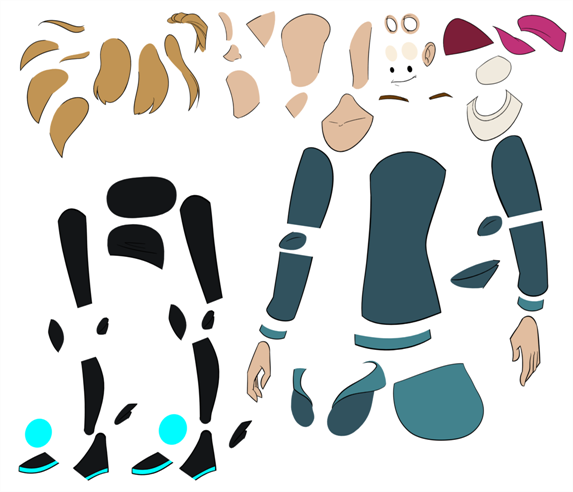
Drawing the Pieces
The main breakdown technique shown hither is to trace your model.
![]() How to break down a character by tracing
How to break down a character by tracing
- In the Timeline view, add a new drawing layer for each body part to separate. You can press Ctrl + R (Windows/Linux) or ⌘ + R (macOS) to add together new drawing layers.
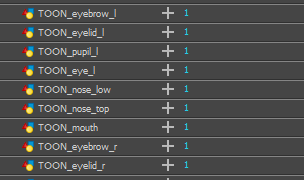
- In the Timeline view, select the layer's first jail cell in which you want to describe the office.

- In the Tools toolbar, select the drawing tool of your selection. There are ii ordinarily used methods to drawing the parts of a cutting-out grapheme model:
These methods ensure each part is made with as few points equally possible, then that they are easy to manipulate, modify or redraw.
- In the Colour view, select a color swatch. If y'all haven't created a palette for your character yet, run into How to Paint.
- If you prefer working in the Drawing view, practice one of the following to display the other layers in done out colours:
- In the Drawing view toolbar, lick the
Low-cal Table button.
- Printing Shift + L.
- In the Camera or Cartoon view, draw the new part.
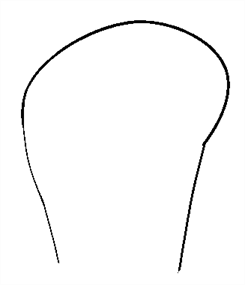
- If you want to close an open up shape without drawing a visible outline, you tin can draw an invisible line using the
Stroke tool.
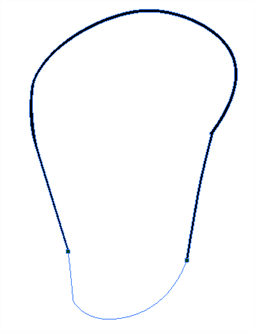
Past default, strokes created with the Stroke tool are non visible. To come across strokes in your drawing, select View > Show > Prove Strokes from the top menu or printing K.
- In the Tools toolbar, select the
Paint or Paint
Unpainted tool to colour your cartoon.
- In the Colour view, create the desired fill colour if it's non already in your palette, and so select information technology.
- In the Camera or Drawing view, paint your drawing.
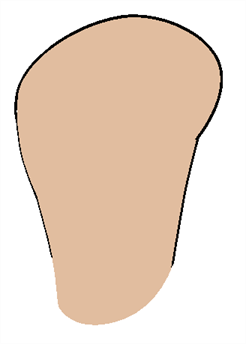
- In the Tools toolbar, select the
Select tool. Select your drawing and flatten the lines by clicking the
Flatten button in the Tool Backdrop view.
- If your lines are composed of several pencil strokes, you might want to combine them into i single smoothen pencil line. Using the Select tool, select the pencil lines to be merged and in the Tool Properties view, click the
Merge Pencil Lines button.

- Repeat the entire process for every body part that y'all wish to make animatable.

Adding Pegs
Pegs are a special type of layer that do not comprise any drawing. They are used strictly to commencement and transform drawings that are under their hierarchy, without transforming the drawings direct.
When rigging or setting up a scene, it is recommended to add parent pegs for each of your drawing layers. This allows yous to continue blitheness keyframes and drawings on separate layers, making information technology easier to work on the position and exposure of your drawing layers independently in the Timeline view. It also makes it easier to create a hierarchy of which trunk parts can exist animated together and independently.

If you want to animate only on pegs, you can actuate the Peg option way of the Transform tool in the Tool Properties view. You can also disable animating cartoon layers, so that just pegs can be animated.
It is also possible to make a drawing layer the parent of another drawing layer. Just like the style animative a peg animates its children layers, animating a drawing layer with children will also animate its children layers. Both layers volition still appear in the animation
.
![]() How to create parent pegs for your layers in the Timeline view
How to create parent pegs for your layers in the Timeline view
- In the Timeline view, select all the layers.
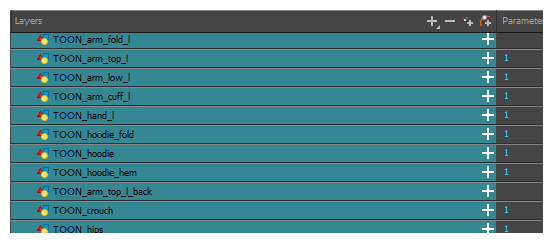
- In the Timeline Layer toolbar, click the Add Peg
button to add a parent peg to all selected layers.

When creating layers or pegs in the Timeline view, your Node view may expect tangled up.
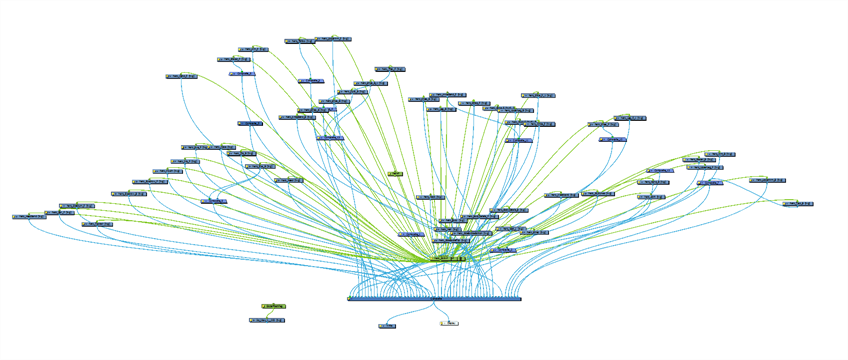
- In the Node view, select all the nodes and, in the Network View toolbar, click the Society Network Downwards
button.
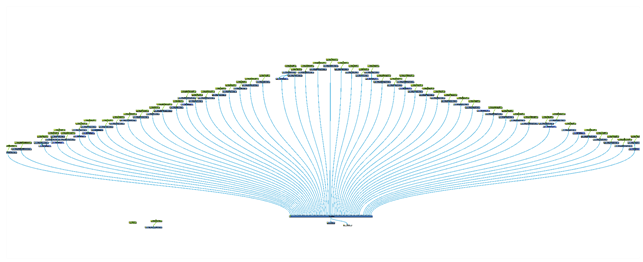
![]() How to create parent pegs for your layers in the Node view
How to create parent pegs for your layers in the Node view
- From the Node view, select all the drawing layers for which you lot want to create pegs.
- Press Ctrl + Shift + P (Windows/Linux) or ⌘ + Shift + P (Mac OS Ten)
- Pegs are created, named and continued to their child drawing layers. They will not automatically connect if the meridian port of your drawing layer is already continued to another node.
- If the nodes are tangled, select all the nodes and, in the Network View toolbar, click the Order Network Down
button.
Creating a Layer Bureaucracy
Harmony lets you build your rig in an elaborate bureaucracy, allowing y'all to fix which parts of your rig should influence other limbs, and how they tin can move independently. For example, when rigging a elementary graphic symbol's arm, you lot tin can make the forearm layer a child of the arm layer, and the mitt layer a child of the forearm layer. This fashion, if the grapheme moves their forearm, the mitt volition follow, and if they move their arm, the forearm and hand volition follow.
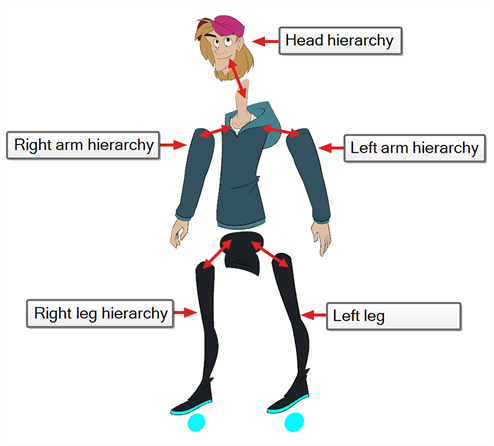
When building a basic character rig, y'all should at to the lowest degree accept a hierarchy for each arm and each leg. You tin can make a hierarchy going from the trunk, the neck and the head, and rig the arms to the torso, and you can rig the legs to the hips. This would brand a hierarchy like this:
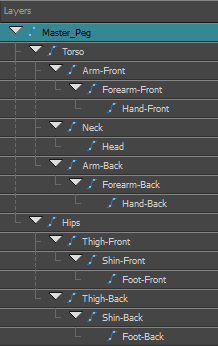
![]() How to create a hierarchy in the Timeline view
How to create a hierarchy in the Timeline view
- In the left surface area of the Timeline view, select the layer which yous want to make a child layer.
- Drag the kid and drop it over the layer which you want to make the parent layer. Brand certain yous are non dropping the kid layer between two layers.
- Repeat until you've created a hierarchy that rigs all of your graphic symbol's parts, with a principal peg at the root. While rigging, if you want several layers to have a common parent, but no existing part of your rig can serve every bit that parent, create a new peg and nest those layers under that peg.

In the Timeline view, you lot can unparent layers by property down Shift, dragging the selected parent abroad from the kid layer and dropping it somewhere else in the list.
![]() How to create a bureaucracy in the Node view
How to create a bureaucracy in the Node view
- Position your nodes as if they were in a tree representing their intended hierarchy, with the highest nodes on top and the everyman nodes at the bottom.
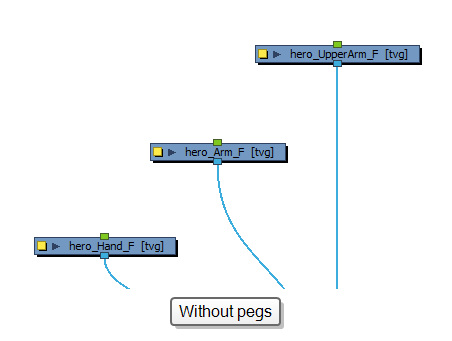

- Elevate a cable from the output port (bottom) of a node which you want to make into a parent node.
- Connect the cable to the input port (meridian) of the node which yous want to make into its child node.
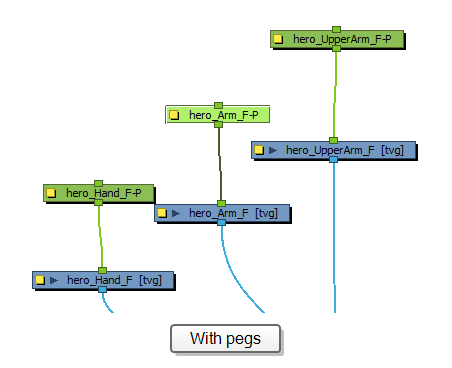
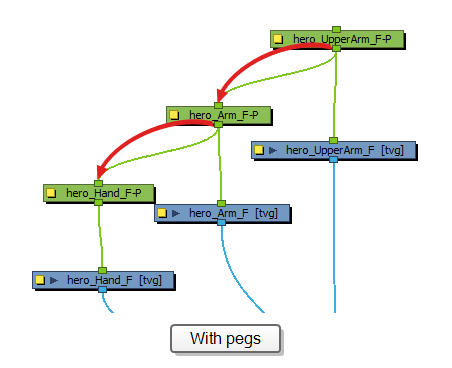
- Repeat until you've created a hierarchy that rigs all of your grapheme's parts, with a master peg at the root. While rigging, if you want several layers to take a common parent, but no existing part of your rig can serve every bit that parent, create a new peg and nest those layers under that peg.
In the Node view, you can unlink nodes from their parent and child by holding downward the Alt key and moving them anywhere in the node view. This will delete the node's connections instantly. If the node has both a parent and a kid, this will automatically connect its onetime parent to its former child.
When rigging, go on in mind that the order of the layers in the Timeline view affects the club in which they are rendered. Layers on superlative of the listing volition be rendered over layers at the bottom of the list.
![]() How to nudge a layer on the Z-axis
How to nudge a layer on the Z-axis
- In the Tools toolbar, select the
Transform tool.
- In the Timeline, Node or Photographic camera view, select the layer you desire to nudge.
- If you selected the layer from the Timeline or Node view, click on the Camera view tab to set the focus on the Photographic camera view.
- Do one of the post-obit:
- To nudge the layer forward, press Alt + Downwards Arrow.
- To nudge the layer backward, press Alt + Up Arrow.
Master Peg
Your character rig should ever have a chief peg which connects to all of its parts. The master peg allows you to manipulate the entire rig from a single layer, without having to dispense each individual role. This is useful for positioning and scaling your character relative to the scene, as well as to breathing your character's trajectory when it has to motility betwixt areas of the scene.

![]() How to add a main peg in the Timeline view
How to add a main peg in the Timeline view
- In the Timeline view, select the top layer.
- In the Timeline view, click on the
Add Peg push button.
A new peg is added to the timeline as a parent of the selected layer.
- Name the new peg
Chiefplus the grapheme's name.
- In the Timeline view, select all the layers y'all want to adhere to your new peg. Recall that your top layer is already a child of the peg, and so don't include it in your selection.
- Drag your option ON to the peg layer to parent all your character'due south pieces to the peg. If your layers are added to a higher place the already parented layers, move that parented layer back on tiptop of the layer stack.
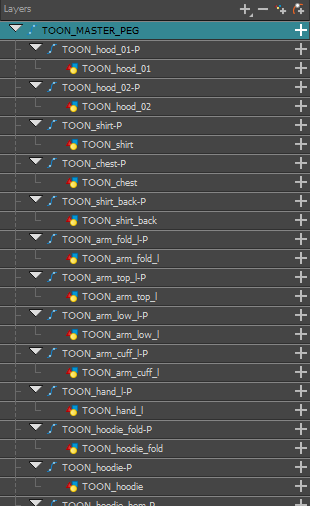
![]() How to add a master peg in the Node view
How to add a master peg in the Node view
- In the Node view, hold Ctrl (Windows/Linux) or ⌘ (macOS) and select each node that you desire to attach to your new peg.
- Exercise one of the following:
- From the Node view menu, select Insert > Peg.
- Press Ctrl + P (Windows/Linux) or ⌘ + P (macOS).
- Rename the new peg
Mainplus the grapheme's name.

Source: https://docs.toonboom.com/help/harmony-20/premium/getting-started/character-building.html
Posted by: hookthonegive.blogspot.com

0 Response to "How To Get Characters Ready For Toon Boom Animate"
Post a Comment